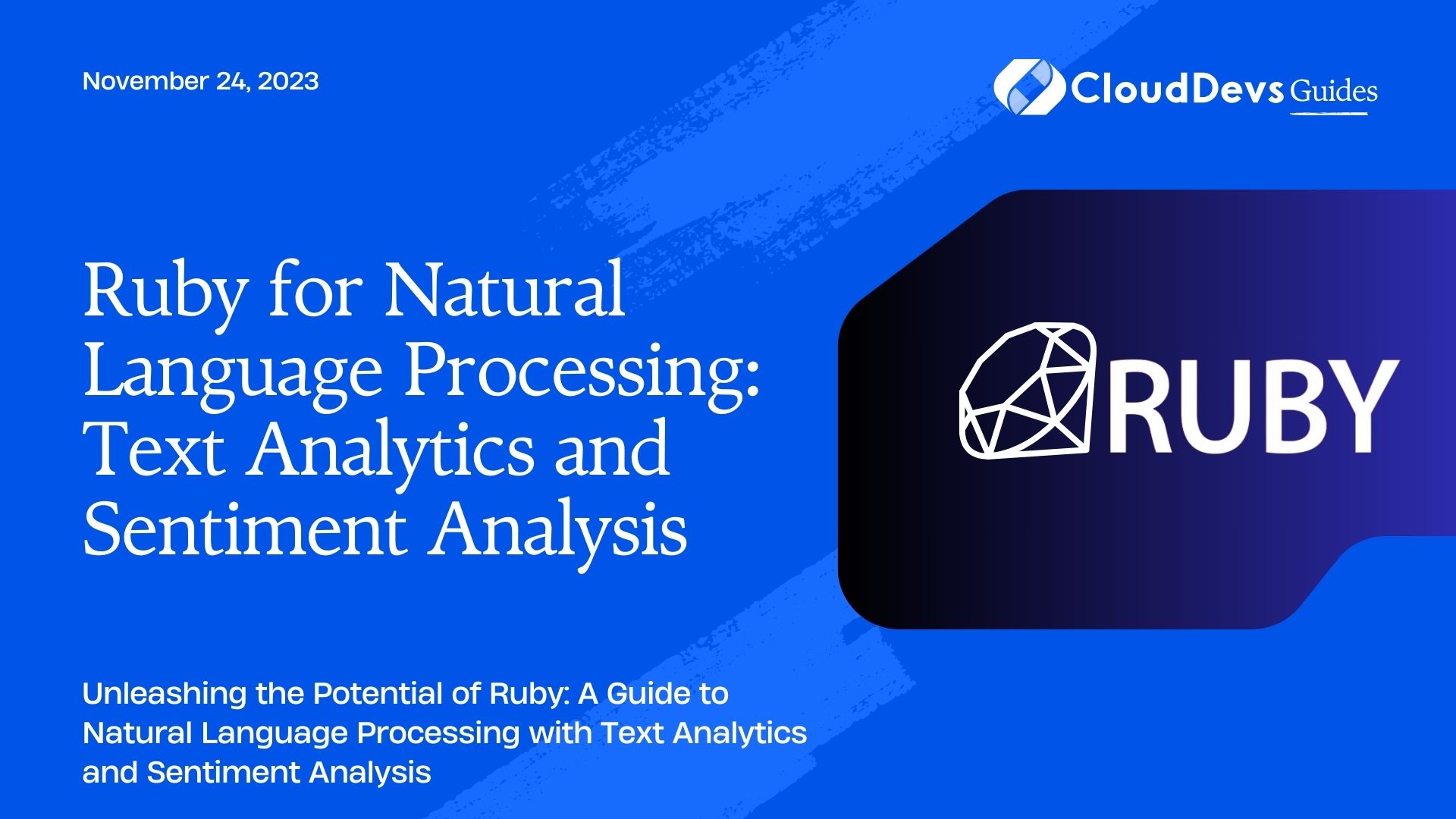Ruby for Natural Language Processing: Text Analytics and Sentiment Analysis
In the rapidly evolving landscape of artificial intelligence, Natural Language Processing (NLP) has emerged as a key field that empowers machines to understand, interpret, and generate human language. As businesses strive to gain deeper insights from textual data, NLP techniques such as Text Analytics and Sentiment Analysis have become crucial tools. In this blog, we’ll embark on a journey to discover how Ruby, a versatile and elegant programming language, can be harnessed for NLP tasks like Text Analytics and Sentiment Analysis. Let’s dive in!
Table of Contents
1. Understanding NLP, Text Analytics, and Sentiment Analysis
1.1. Unveiling Natural Language Processing (NLP)
Natural Language Processing, or NLP, is the branch of artificial intelligence that focuses on enabling computers to understand, interpret, and respond to human language in a way that is both meaningful and contextually relevant. NLP techniques empower machines to process and analyze vast amounts of textual data, opening doors to applications like language translation, chatbots, and sentiment analysis.
1.2. The Power of Text Analytics
Text Analytics involves extracting valuable insights from textual data. It encompasses a range of techniques, from simple tasks like word frequency analysis to more complex operations like named entity recognition and topic modeling. Text Analytics aids in understanding trends, patterns, and relationships within text, which can be immensely beneficial for decision-making and understanding customer preferences.
1.3. Decoding Sentiment Analysis
Sentiment Analysis, a subset of Text Analytics, focuses on determining the emotional tone or sentiment expressed in a piece of text. By analyzing words and phrases, machines can classify text as positive, negative, or neutral, providing valuable insights into customer opinions, public sentiment, and brand perception.
2. Leveraging Ruby for NLP Tasks
2.1. Why Ruby?
Ruby, known for its elegant and readable syntax, is often associated with web development. However, its versatility extends beyond that. With a vibrant community and a wide range of libraries, Ruby is a capable choice for NLP tasks as well. Let’s explore how to perform Text Analytics and Sentiment Analysis using Ruby.
2.2. Text Preprocessing with Ruby
Before diving into the intricacies of Text Analytics, proper preprocessing is essential. Let’s see how Ruby can be used to prepare text data for analysis.
ruby # Sample text for preprocessing text = "NLP with Ruby makes text analytics exciting and accessible!" # Convert text to lowercase text = text.downcase # Remove punctuation text = text.gsub(/[[:punct:]]/, '') # Tokenization - Split text into words words = text.split
In the code above, we’ve converted the text to lowercase, removed punctuation, and tokenized it into individual words. These steps ensure uniformity and ease in further analysis.
2.3. Word Frequency Analysis
One of the fundamental aspects of Text Analytics is understanding word frequency within a given text. Ruby’s built-in Hash structure can be utilized for this purpose.
ruby
# Count word frequency
word_frequency = Hash.new(0)
words.each { |word| word_frequency[word] += 1 }
# Display word frequency
word_frequency.each { |word, frequency| puts "#{word}: #{frequency}" }
The code snippet above demonstrates how Ruby can efficiently count word frequency using a Hash.
2.4. Performing Sentiment Analysis with Ruby
Sentiment Analysis involves classifying text into positive, negative, or neutral sentiments. Ruby offers tools to achieve this classification using predefined lexicons.
ruby
# Sample text for sentiment analysis
sentiment_text = "I absolutely love this product! It's fantastic."
# Sample positive and negative words
positive_words = ["love", "fantastic"]
negative_words = ["hate", "disappointing"]
# Count positive and negative words
positive_count = sentiment_text.split.count { |word| positive_words.include?(word) }
negative_count = sentiment_text.split.count { |word| negative_words.include?(word) }
# Determine sentiment based on counts
if positive_count > negative_count
sentiment = "Positive"
elsif negative_count > positive_count
sentiment = "Negative"
else
sentiment = "Neutral"
end
puts "Sentiment: #{sentiment}"
In this code example, we define a list of positive and negative words, count their occurrences in the text, and determine the overall sentiment based on the counts.
3. Ruby Gems for Advanced NLP
3.1. The ‘nlp’ Gem
The ‘nlp’ gem is a powerful tool for various NLP tasks in Ruby. It offers functionalities like tokenization, stemming, and part-of-speech tagging.
ruby
require 'nlp'
# Sample text for NLP tasks
nlp_text = "Ruby's NLP capabilities are fascinating!"
# Tokenization
tokens = NLP.tokenize(nlp_text)
puts "Tokens: #{tokens}"
# Stemming
stemmer = NLP::PorterStemmer.new
stemmed_words = tokens.map { |token| stemmer.stem(token) }
puts "Stemmed words: #{stemmed_words}"
# Part-of-speech tagging
pos_tags = NLP.pos_tag(tokens)
puts "POS tags: #{pos_tags}"
The ‘nlp’ gem simplifies complex NLP tasks by providing pre-built functionalities for tokenization, stemming, and part-of-speech tagging.
3.2. The ‘sentimental’ Gem
The ‘sentimental’ gem is specifically designed for Sentiment Analysis in Ruby. It employs a sentiment lexicon to classify text sentiment.
ruby
require 'sentimental'
# Load the sentiment lexicon
Sentimental.load_defaults
# Analyze sentiment
analyzer = Sentimental.new
sentiment = analyzer.sentiment("Ruby makes NLP tasks enjoyable!")
puts "Sentiment: #{sentiment}"
The ‘sentimental’ gem streamlines Sentiment Analysis by utilizing a sentiment lexicon to classify text sentiment with ease.
Conclusion
In the realm of Natural Language Processing, Text Analytics and Sentiment Analysis play a pivotal role in unraveling the hidden insights within textual data. With the power of Ruby and its dedicated gems, performing these tasks becomes both accessible and efficient. From text preprocessing to sentiment classification, Ruby provides an elegant and versatile platform for NLP enthusiasts and professionals alike. As you embark on your NLP journey, remember that with Ruby, the possibilities are as limitless as the language itself.
Table of Contents








